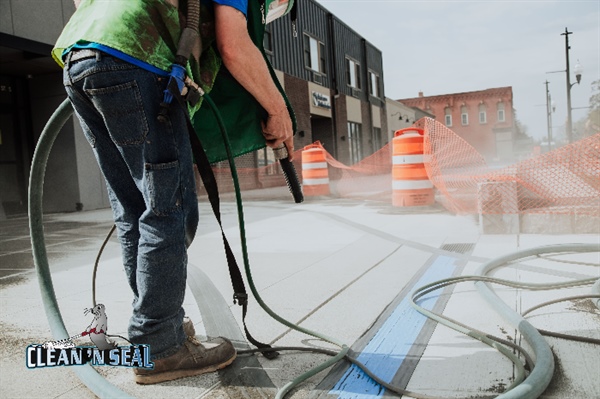Essential Safety Precautions for Media Blasting on Commercial Buildings

Media blasting is a powerful and effective method used in commercial buildings to clean, restore, or prepare surfaces. However, due to the high-pressure nature of this technique and the materials involved, safety is a paramount concern.
Ensuring that all necessary precautions are taken can prevent accidents and guarantee the well-being of workers and surrounding areas.
Whether you're a contractor or a building owner, understanding these safety precautions is essential for successful and safe media blasting operations. Keep reading to learn more about the critical steps you should take to protect everyone involved and maintain the integrity of the building.
What Protective Gear Is Required for Safe Media Blasting?
When performing media blasting, the safety of workers is highly dependent on the proper use of protective gear. Due to the high velocity of abrasive materials, workers are exposed to various risks, including inhalation of harmful particles, skin injuries, and eye damage.
To mitigate these risks, it is essential to equip all personnel with the necessary protective gear:
- Full-face respirator or a blasting hood: This shields the face and prevents inhalation of dust and particles.
- Heavy-duty gloves, long sleeves, and full-body suits: These items protect against abrasions.
- Steel-toed boots: Boots are also recommended to safeguard against foot injuries.
- Ear protection, such as earmuffs or earplugs: These are critical to prevent hearing loss due to the noise generated by blasting operations.
Ensuring that all workers are properly fitted with this protective gear is not just a regulatory requirement but a crucial step in preventing accidents and long-term health issues.
How Should the Work Area Be Prepared to Minimize Hazards?
Before beginning any media blasting operation, it is essential to thoroughly prepare the work area to minimize potential hazards.
- Clearing the area of any unnecessary equipment or debris that could become a hazard during the blasting process.
- Barriers should also be set up to prevent unauthorized personnel from entering the blasting zone, ensuring that only trained and properly equipped workers are present.
- Cover or remove any sensitive materials or equipment in the vicinity that could be damaged by the blasting process. This includes using protective sheeting or tarps to cover windows, doors, and other openings.
- Ensure proper airflow to help dissipate dust and airborne particles, reducing the risk of inhalation.
Proper preparation of the work area not only protects workers but also minimizes the risk of damage to the building or surrounding environment.
This meticulous approach is a hallmark of the cleaning services we provide at Clean N' Seal.
What Are the Potential Risks of Media Blasting Near Windows & Glass Surfaces?
Media blasting near windows and glass surfaces presents specific risks that must be carefully managed to avoid costly damage.
The abrasive materials used in blasting can easily scratch or shatter glass if not handled correctly. Therefore, it is crucial to assess the proximity of glass surfaces to the blasting area and take appropriate protective measures.
One of the most effective ways to protect windows and glass surfaces is to cover them with a thick protective film or board them up entirely if possible.
This barrier helps to absorb the impact of the blasting material, reducing the likelihood of damage. Adjusting the blasting pressure when working near glass can also prevent accidental breakage.
Another consideration is the direction of the blast. By angling the blast away from glass surfaces and maintaining a safe distance, the risk of direct impact is minimized.
What Are the Best Practices for Disposing of Media Blasting Debris?
Disposing of media blasting debris requires careful consideration to ensure compliance with environmental regulations and to maintain a clean worksite. The debris generated from media blasting often contains hazardous materials, such as paint chips, metal fragments, or other contaminants, which must be handled with care.
First, it's important to segregate the debris based on its composition. For example, recyclable materials, such as certain types of metal, should be separated from non-recyclable waste.
Hazardous waste, particularly materials containing lead or other toxins, must be disposed of according to local regulations, often requiring special handling and disposal procedures.
Proper disposal not only adheres to environmental guidelines but also helps maintain the cleanliness and safety of the worksite. At Clean N' Seal, we prioritize environmentally responsible practices in all our operations.
Clean 'N Seal Offers Worry-Free Commercial Concrete Cleaning
At Clean N' Seal, we understand the complexities and risks involved in media blasting, particularly in commercial settings. Our team is equipped with the expertise and the right tools to ensure that all safety precautions are strictly followed.
From providing the necessary protective gear to properly preparing the work area and ensuring the safety of surrounding areas, we cover all aspects of media blasting with precision.
If you are looking for a reliable partner to assist with media blasting, whether for cleaning, restoration, or surface preparation, Clean N' Seal offers comprehensive services that prioritize safety and quality.
Contact us at 952.393.9588 or to request an estimate for more information about our commercial services.